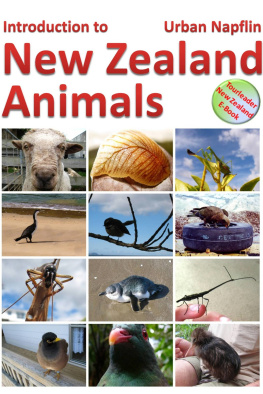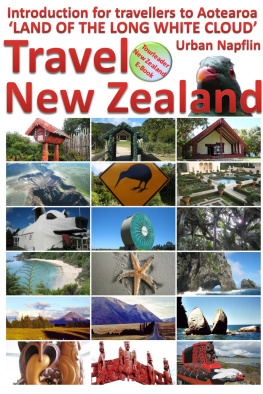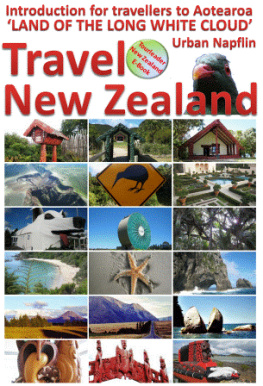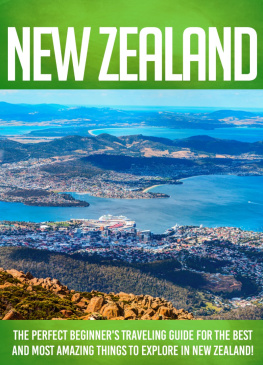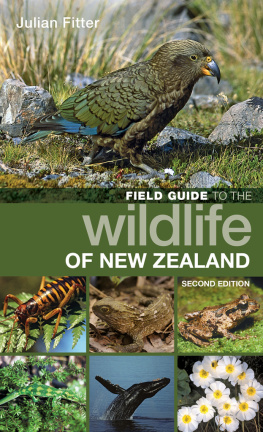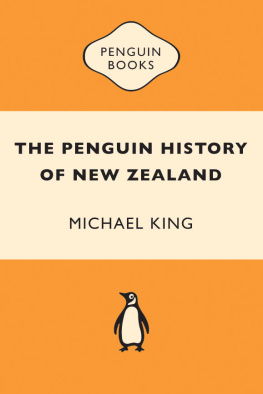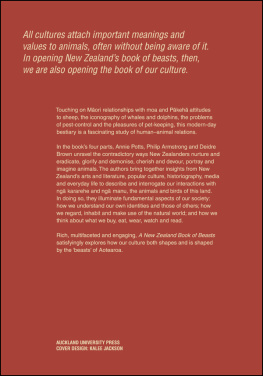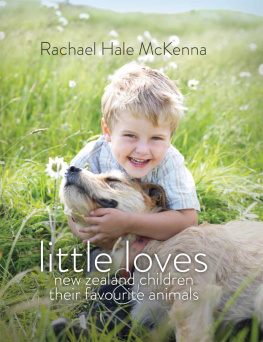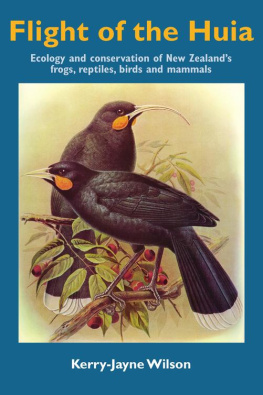Introduction to New Zealand Animals
A Short Introduction to the Unique Wildlife of New Zealand
Urban Napflin
Copyright
Smashwords Edition Version 3.1
Copyright 2018 Urban Napflin, Whangarei Tours Ltd, Tourleader New Zealand
All rights reserved. This ebook may not be re-sold or given away to other people.
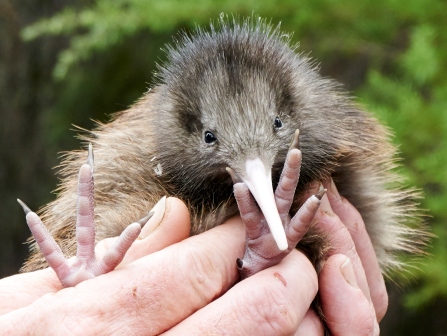
Also published by the same author:
Maori Language - An Introduction for Travellers and Newcomers
Travel New Zealand - An introduction for travellers to Aotearoa, the land of the long white cloud
Table of contents
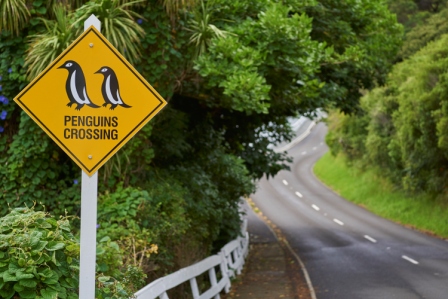
Introduction to New Zealand animals
New Zealand's nature is not only so fascinating because 80 million years of isolation from the Godwana-continent has resulted in the development of unique animals, but also because this primordial state lasted up until a very short time ago, until the first human influence. The Gondwana survivors had a very diverse and amazing landscape as a stage for their evolution, which was too isolated for almost all potential kinds of immigrants.
25% of birds in general, 87% of terrestrial birds and 90% of insects are endemic , which means they appear nowhere else. The absence of land mammals meant that birds could occupy their niche, roaming on the forest floor for food, unafraid of predators. Some nested on the floor or even lost the ability to fly, with devastating effects once mammals like Polynesian rats, dogs, possums and stoats were introduced. 800 years of human co-existence (0.0001% since Gondwana) was enough to extinct half of all bird species, while over 70% of all land bird species are currently threatened . Their habitat has reduced drastically, originally 85% of the land mass was forested, but even before the arrival of Europeans it was down to 53%. Farming reduced it further but today it stays about the same level thanks to exotic forest plantations. Also many species of fish, bats, frogs, insects, marine mammals and reptiles are endangered. New Zealanders work hard towards conservation of these animals, sadly most numbers show a further decline.
Conservation programmes in predator-free reserves and wildlife centres help to keep numbers up, best achieved on offshore islands. Meanwhile also some 'mainland islands' have been established, areas well protected against intruders. Also you as a visitor can help by volunteering in a conservation project during your stay (see the last section).

Thorny Weevil
Please refer to the online picture gallery for more illustrations: www.tourleader.co.nz/new-zealand-animals/new-zealand-animals.htm .
Extinct animals
Moa
The Giant Moa was up to an amazing 270 kg weight and over 3,5 metres tall, the tallest bird ever! An egg with a volume of 4 litres was found in Kaikoura, the equivalent of 60 hen's eggs. There were 10 more species all the way down to Turkey size, taking over the niches otherwise dominated by antelopes or kangaroos. Apart from their bones, gizzard stones are also found which they swallowed to grind and crush twigs and plants they foraged on.
Kiwi are the closest remaining relatives of Moa, although Moa were present since Gondwana times whereas Kiwi are thought to have flown over from Australia about 40 million years ago and became flightless independently - Kiwi still have tiny wings, Moa none at all. Other Moa relatives ('Ratites') were the Madagascan Elephant Birds, the Sylviornis of New Caledonia, South American Rheas, African Ostriches and the Emus and Cassowaries of Australia.
Early Maori settlers concentrated on hunting Moa, understandably as it was easy to catch and one drum stick fed many people, but within 100 years the bird was extinct. Moa never lived on offshore islands.
Some New Zealand plants have adapted to avoid being grazed by Moa, their leaves keep an extremely low nutritional value until they reach a safe height of about 3 metres and then change into regular trees, such as the Lancewood (Horoeka).
There was another unrelated giant flightless bird around called the Aptornis or Adzebill (80 cm long and weighing 18 kg), which also became extinct during Maori settlement.
More than half of all original endemic birds were flightless or near-flightless, flight from predators was simply not necessary. Flight requires more energy than walking and restricts size, being bigger also has advantages in colder climates because of possible fat storage and warmth preservation.
Haast Eagle (Pouakai)
The Haast Eagle, the largest bird of prey ever known , was up to 15 kg with a 3 metre wingspan and shot down from the sky surprising its victims, mostly flightless birds. Being a threat to humans - especially children - it was probably hunted by Maori. They became extinct at around 1400. At the same time Moa were disappearing.
The Haast Eagle underwent one of the fastest evolutionary changes ever recorded, from one of the smallest Australian eagles (Hieraatus morphnoides) to a species 10 times heavier within just 1 million years.
Huia
A beautiful bird with an arched beak, its sacred feathers were worn by Maori chiefs only . Only the females had an extreme shaped beak, which was up about 10 cm long, maybe a result of different food choices between males and females. It belonged to an ancient bird family, but has not been seen for 100 years. A half-hearted failed conservation effort wasn't helped by their feathers and beaks turning into fashionable accessories in Europe.
Giant Penguin
Extinct millions of years ago, these scary penguins were up to 1,7 m tall and weighed up to 100 kg, the tallest penguins ever . There were at least 13 other New Zealand now extinct penguin species. There are theories claiming that penguins evolved their flightlessness in New Zealand.
Flightless Wrens
These little song-birds were, so to speak, the New Zealand mice of the forest, who occupied their forest floor niche so well that the ability to fly became unnecessary. Their discovery took place about the same time as their extinction: the last Flightless Wrens lived on Stephens Island north of the South Island, at the end of the 19th century. 16 unlucky ones alone fell victim as specimens for scientific investigation and curiosity. Unfortunately they had no chance to survive in a new era with introduced rats, dogs and cats. They were the smallest flightless birds in the world .
The wrens are in a way New Zealand's most ancient birds, having separated from their ancestral lines 80 million years ago, 12 million years earlier than the Kiwi! The only related species left today are the Rifleman and the New Zealand Rock Wren .
Birds
Kiwi
Truly unique birds : they havewhiskers like cats which help them find their way at night, long beaks with great smelling sense, tiny wings and no tail. Their beautiful feathers were treasured by Maori, they also lay the biggest eggs compared to body size - probably the eggs are so big because the Kiwi ancestors were once bigger than the current species. The only bird in the world with nostrils at the tip of the beak, ideal for smelling underground worms and insects (you'll hear them clear their nostrils after digging around!). Being nocturnal, their daytime is spent in burrows or undergrowth.
Usually the males and not the females incubate the eggs, for about 80 days, which is one of the longest periods for birds (there are birds with 11 days incubation only!). The result is that the chicks are very independent from the moment of their hatching.
Next page
